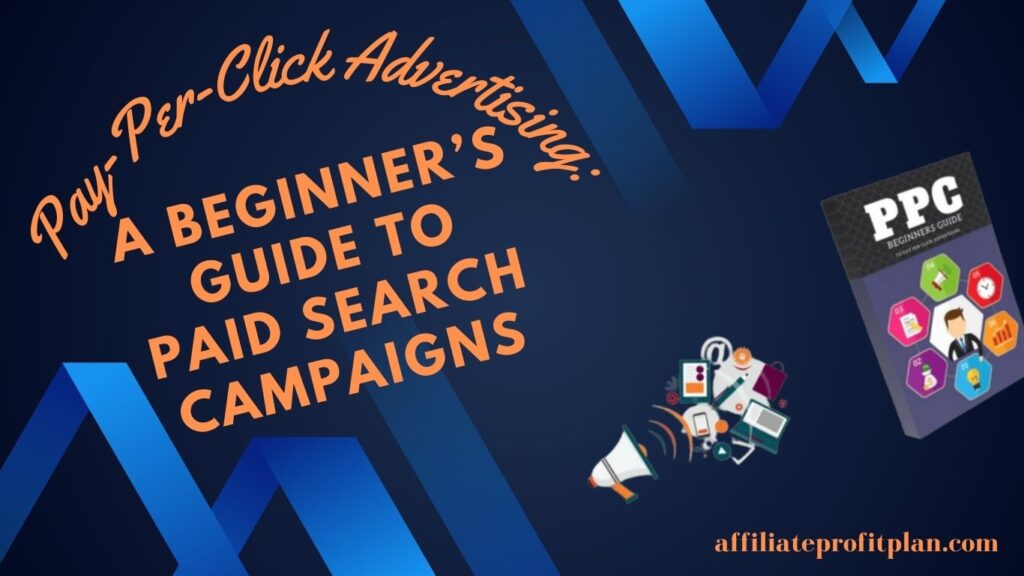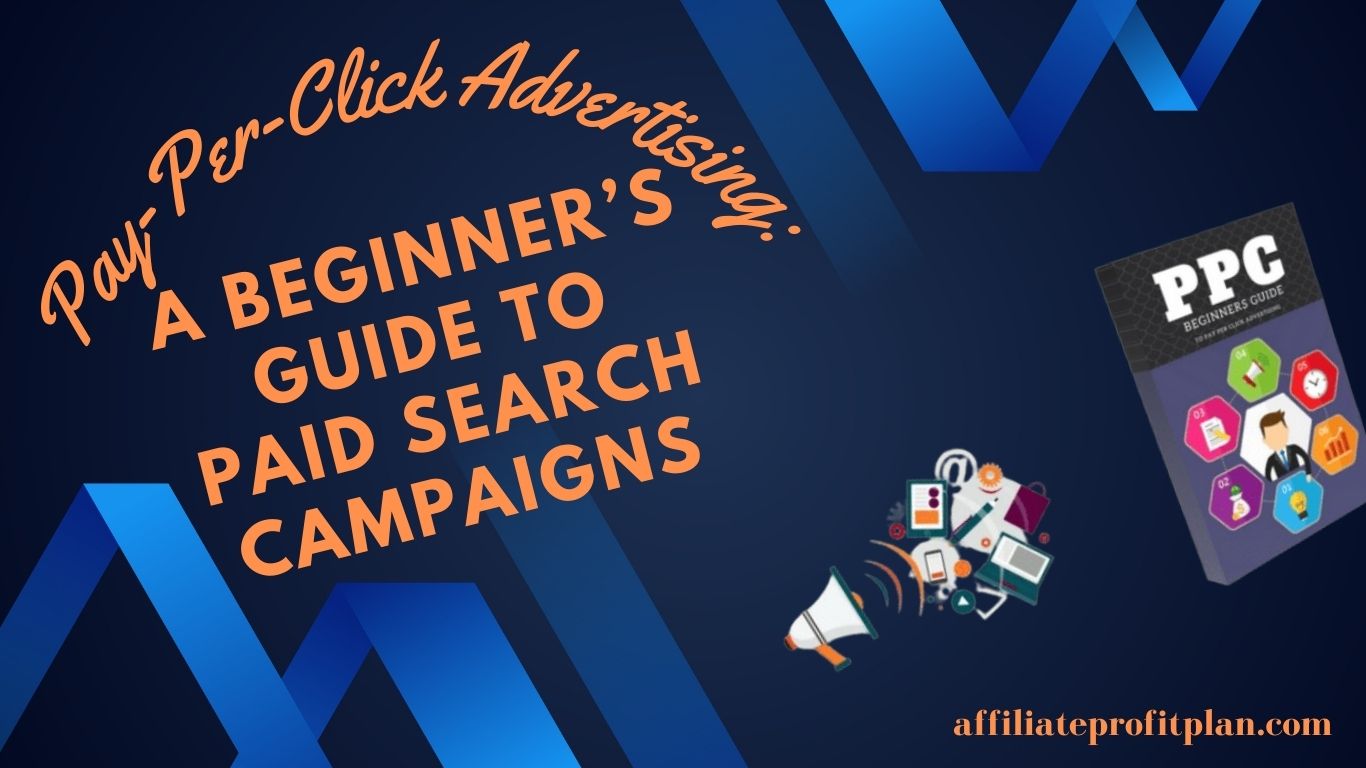Welcome to my article Pay-Per-Click Advertising: A Beginner’s Guide to Paid Search Campaigns. So, you’ve heard the term “Pay-Per-Click” (PPC) floating around, but what exactly does it mean, and why should you care? Well, imagine you’re running an online store and you want your products to be seen by thousands of potential customers. But how do you stand out in the overcrowded digital marketplace without waiting for months to build organic traffic? Enter PPC advertising — where you pay a small fee every time someone clicks on your ad. It’s like paying for a ticket to a concert where you only have to pay once people actually show up and take a seat.
In this beginner’s guide, we’ll walk you through the ins and outs of setting up a PPC campaign. Whether you’re eyeing Google Ads, Bing Ads, or social media platforms, we’ll show you how to create an effective paid search strategy that drives traffic and boosts conversions. We’ll break down everything from understanding the auction system and crafting compelling ads, to optimizing your budget and avoiding rookie mistakes. PPC advertising is a great way to kickstart your digital marketing efforts, and with the right approach, it can deliver real results — without needing to be a marketing guru. Ready to dive in? Let’s go!
Access My Proven Blueprint for $50-$100 Daily Income – Watch This FREE Video Now >>>

What is Pay-Per-Click (PPC) Advertising?
Alright, let’s get down to the basics. Pay-Per-Click, or PPC, is a type of online advertising where you, the advertiser, pay a fee each time someone clicks on your ad. Think of it as a digital version of paying for a billboard, but instead of paying for it to be seen by thousands of people, you’re only paying for the ones who actually stop and take a look. It’s a pretty efficient way to get your message in front of the right people without throwing money into the wind.
Here’s how it works: you bid on keywords (terms or phrases people search for) that are relevant to your business. For example, if you run a bakery, you might bid on terms like “best chocolate cake near me” or “buy homemade bread.” When someone types those keywords into a search engine like Google, your ad might pop up on the results page. And, here’s the kicker: you only pay when someone clicks on your ad, not when it’s just displayed. Pretty cool, right?
PPC advertising is often used on platforms like Google Ads, Bing Ads, and even social media sites like Facebook and Instagram. It’s a way to “buy” traffic to your website, whether you’re aiming for more leads, sales, or brand awareness. The best part? You control your budget. If you only want to spend $10 a day, you can set that limit. No surprise bills at the end of the month! The goal, of course, is to spend wisely so that those clicks turn into conversions (sales, sign-ups, etc.). The more targeted your ads, the better your results — and the less you’ll pay for each click. In short, PPC is the online advertising equivalent of working smarter, not harder!
Setting Up a PPC Campaign
Alright, now that you’ve got the basics of PPC down, it’s time to roll up your sleeves and set up your first campaign. Don’t worry, it’s not as complicated as it sounds — in fact, once you break it down into steps, it’s pretty straightforward. Just like putting together a piece of IKEA furniture, you just need to follow the instructions (and maybe avoid banging your head against the wall once or twice). Let’s walk through the essential steps of getting your PPC campaign up and running!
1. Create Your Account and Choose Your Platform
The first step is simple: pick your platform. If you’re looking to advertise on search engines, Google Ads is the reigning champion, but there are other options like Bing Ads and even social media platforms like Facebook or Instagram. Once you’ve picked your platform, you’ll need to create an account (don’t worry, they won’t ask for your firstborn child). After that, you’ll be ready to dive into the fun stuff: actually setting up your campaign.
2. Define Your Campaign Goals
Now, this is the part where you need to get clear about what you’re trying to achieve. Are you looking to boost website traffic? Generate leads? Or maybe get people to sign up for your newsletter? Defining your goal is crucial because it will shape everything that follows, from your ad copy to your bidding strategy. It’s like deciding whether you want a taco or a burrito — both delicious, but the ingredients are different.
3. Choose Your Target Audience
Next, you’ll want to define your audience. Are you targeting people who live in your city, or do you want to cast a wider net? PPC platforms let you target based on location, language, device type, and even interests or behaviors. This helps ensure your ads are reaching the right people — you don’t want to be advertising your vegan bakery to people who think kale is just a weird salad garnish. Be sure to use the targeting tools available to make your campaign as efficient as possible.
4. Pick Your Keywords
Now we get into the heart of the campaign: keywords. These are the terms people will type into search engines when they’re looking for what you offer. You’ll want to conduct some keyword research to find terms that have high search volume but aren’t too competitive. There are plenty of tools out there (like Google Keyword Planner) that can help you identify keywords related to your business. Remember, the more specific and relevant your keywords are, the better your chances of converting those clicks into actual sales. It’s like fishing with a perfectly baited hook!
5. Write Your Ads
This is where you get to flex your creative muscles! Your ad copy needs to grab attention, spark interest, and drive action — all in a matter of seconds. Focus on writing a catchy headline, include a clear value proposition, and finish with a strong call-to-action (CTA). A good CTA is like a friendly nudge saying, “Hey, click me!” The more relevant your ad is to the searcher’s intent, the higher the chance they’ll click.
6. Set Your Budget and Bids
This is where you’ll need to make a decision on how much you’re willing to spend. PPC advertising works on an auction system, meaning you’ll bid on keywords and the highest bidder typically gets the prime ad space. But don’t panic — you don’t need a bottomless budget to succeed. Start small, monitor your results, and adjust accordingly. Platforms like Google Ads let you set daily or monthly budgets, so you won’t accidentally blow all your cash in one go. Think of it as a “pay as you go” system for your ads — no surprise bills here!
7. Launch and Monitor Your Campaign
Once everything’s set up, it’s time to hit that magical “Launch” button. But don’t just sit back and relax — PPC is all about continuous monitoring and optimization. Track metrics like click-through rate (CTR), cost-per-click (CPC), and conversion rate. If certain ads aren’t performing well, tweak the copy, try different keywords, or adjust your bids. PPC is a bit of an experiment, and the more you test and optimize, the better your results will be.
And there you have it — your first PPC campaign is live! Don’t worry if it feels a bit overwhelming at first; with time, you’ll get the hang of it. It’s like learning to ride a bike — a little wobbly at first, but once you get your balance, you’ll be zooming toward your goals. Happy campaigning!
Crafting Effective Ads and Landing Pages
Alright, you’ve set up your PPC campaign — great job! Now comes the fun part: crafting ads that make people stop scrolling, and landing pages that turn those clicks into real results. Think of your ad as the first impression on a first date, and your landing page as the “getting to know you” part. Both need to impress, engage, and ultimately seal the deal. Here’s how to do it!
Access My Proven Blueprint for $50-$100 Daily Income – Watch This FREE Video Now >>>
1. Writing Irresistible Ad Copy
Let’s face it: the average internet user is busy. They’re probably juggling 17 tabs, an email inbox full of unread messages, and a new viral TikTok video to watch. So, your ad needs to stand out — fast. The secret sauce for irresistible ad copy is clarity, relevance, and a dash of excitement.
First, start with a headline that grabs attention. Your headline should directly address the problem your audience is facing or offer a solution they can’t resist. If you’re advertising a fitness program, for example, a headline like “Get Fit in 30 Days – No Gym Required!” speaks directly to the desire for a quick, accessible solution.
Next, make sure your description expands on the headline and clearly explains why they should click. Keep it concise, focus on benefits over features, and use language that resonates with your target audience. And don’t forget your call-to-action (CTA) — this is your “ask.” Whether it’s “Shop Now,” “Get Started,” or “Learn More,” make sure your CTA stands out and tells the reader exactly what they should do next. Your CTA should feel like a gentle push, not a hard shove!
2. Matching Your Ad to Your Landing Page
Okay, now we’ve got people clicking on your ad. But what happens next? They land on your page, and this is where the magic happens. Your landing page needs to follow through on the promise you made in the ad. If your ad said, “Get Fit in 30 Days,” don’t send them to a generic homepage with 20 different products. That’s like inviting someone to dinner and then giving them the menu to a 5-star restaurant — too many choices, too much overwhelm.
Your landing page should be simple, focused, and relevant to the ad that brought them there. The message should match the ad’s promise and provide clear, easy-to-understand next steps. If the ad was about a fitness program, the landing page should have a clear headline like, “Join Our 30-Day Fitness Challenge Today” and a CTA like “Start Your Free Trial.” Make sure to avoid distractions. Less is more — no unnecessary links or clutter that can cause them to lose focus. Remember, your goal is one thing: convert that click into an action.
3. Design Matters: Keep It Clean and Simple
You might have the best offer in the world, but if your landing page looks like a toddler’s art project, you might lose some clicks before they even read the copy. The design of your landing page matters, and it doesn’t have to be complicated. Keep it clean, professional, and easy to navigate. Use white space to give your content room to breathe, and make sure the CTA button is prominently placed — it should be impossible to miss, but not in a “buy-now, buy-now, buy-now” aggressive way.
Also, ensure your landing page is mobile-friendly. Many people are browsing on their phones, so if your page doesn’t look good or function well on mobile, you’re going to lose a lot of potential customers. It’s like trying to fit a square peg in a round hole — it just doesn’t work.
4. Optimizing for Conversions
This is where the real magic happens. Creating ads and landing pages that get clicked is great, but getting them to convert is the goal. This is where A/B testing comes into play. A/B testing allows you to test different versions of your ads and landing pages to see which one performs better. You might test two headlines or try different images. Maybe your CTA should say “Get Started” instead of “Learn More.” Testing these variables helps you refine your approach and improve your conversion rate over time.
You also want to ensure your landing page has a clear and easy path for users to follow. If you’re offering a lead magnet like an ebook or free webinar, ensure that the form is easy to fill out and doesn’t ask for too much info. Asking for their life story is a surefire way to make them bail. The fewer barriers you create, the higher the chances they’ll follow through with the action you want.
5. Include Social Proof and Trust Signals
People like to know that others are happy with what they’re about to sign up for, so make sure to include testimonials, reviews, or case studies on your landing page. A glowing review or testimonial can provide the extra nudge they need to make that purchase or sign-up. If you can, add trust signals like security badges or certifications to reassure users that their personal info is safe. Trust is key in the online world, and the more you can show you’re reliable, the more likely they are to convert.
Monitoring and Optimizing Your PPC Campaign
You’ve launched your PPC campaign, and clicks are rolling in—success, right? Well, not so fast. Much like keeping plants alive, running a successful PPC campaign requires regular monitoring, a keen eye for what’s working (or wilting), and a few timely adjustments. Let’s break down how you can make sure your PPC efforts aren’t just sprouting, but blooming into a campaign that really converts.
Key Metrics to Watch
Before you start tweaking, it’s essential to understand what to look at. PPC comes with a whirlwind of metrics, but don’t worry—you don’t need to analyze every number under the sun. Focus on the essentials: Click-Through Rate (CTR), Conversion Rate, Quality Score, Cost Per Click (CPC), and Return on Ad Spend (ROAS). Think of these as your campaign’s vital signs. A high CTR shows your ad is grabbing attention, but the Conversion Rate tells you if those clicks are doing their job. And if CPC is creeping up, it might be time to adjust your bidding strategy. Quality Score? That’s Google’s way of telling you how relevant and delightful your ad is to searchers, so you definitely want it high.
Digging Into the Data
Once you’ve got a handle on the metrics, it’s time to look deeper. Start by analyzing which keywords, ads, and audiences are delivering results, and which are costing you without a return. Spot an underperforming ad? It might be time to refresh the copy, update the call-to-action, or experiment with different visuals. Platforms like Google Ads provide detailed reports that show how users are interacting with your ads, from clicks to conversions. The trick is to use this data to refine your approach—don’t be afraid to A/B test ad variations and try different landing page layouts. Testing might feel tedious, but it’s the only way to ensure your campaign keeps improving.
Optimization Tips and Tricks
Now that you’re monitoring like a pro, let’s talk about optimization. A good place to start is negative keywords—those irrelevant terms that are just eating into your budget. Adding these is like weeding out plants you don’t want in your garden, leaving room for the ones you do. Next, consider tweaking your bid strategy. If a specific ad group is performing well, increase the bid to give it more visibility; for those not-so-great ones, cut back to save funds. And don’t forget ad extensions—those little extras like site links and callouts can boost your ad’s real estate on the search results page, attracting more clicks without any extra cost.
Regular Optimization Is Key
The bottom line? Your PPC campaign isn’t a “set it and forget it” deal. Regular optimization is the key to keeping costs low and results high. Check in at least once a week (or daily if you’re in a competitive industry), make adjustments based on your data, and keep experimenting. A well-monitored, optimized PPC campaign can turn those clicks into conversions and give your business the boost it needs—all while helping you avoid any nasty surprises on your credit card bill.
Common Mistakes to Avoid and Tips for Success
Running a Pay-Per-Click (PPC) campaign is like driving a car — you’ve got to know when to press the gas pedal and when to hit the brakes. But even the best drivers make mistakes (hey, we’ve all taken a wrong turn), and when it comes to PPC advertising, there are some common pitfalls you want to avoid if you don’t want to burn through your budget faster than you can say “conversion rate.” Luckily, with a little bit of awareness and a few helpful tips, you can steer clear of these mistakes and set yourself up for PPC success. So, let’s buckle up and dive into the most common PPC missteps — and how you can avoid them like a pro!
1. Failing to Set Clear Goals
Before you even think about drafting your first ad, ask yourself: What do you want to achieve? Do you want more website traffic? Are you looking for sales? Or maybe you’re trying to grow your email list? Failing to define clear, measurable goals is like starting a road trip without a map or a destination. You’ll end up lost, wasting time, and driving in circles.
Tip: Make sure you set specific goals with clear key performance indicators (KPIs). Whether it’s increasing clicks, boosting sales, or improving your return on ad spend (ROAS), having a defined goal helps guide your PPC strategy and ensures you’re measuring the right results. Plus, it’s easier to stay on track when you know where you’re headed!
2. Targeting Too Broad or Too Narrow
One of the biggest mistakes newbie PPC advertisers make is casting a net that’s either too wide or too tight. Targeting too broadly means your ads are reaching people who aren’t interested in your product, wasting your budget on clicks that don’t convert. On the other hand, targeting too narrowly can mean you’re missing out on valuable opportunities and reaching too small of an audience. It’s like fishing with a net that’s either too small or too big — either way, you’re not going to catch much.
Tip: Use granular targeting options to hit the sweet spot between broad and narrow. Focus on your ideal customer — their location, interests, device use, and more. Test different audiences, adjust your targeting, and refine your approach over time. You want to reach the right people, not just anyone with a pulse.
3. Ignoring Mobile Optimization
Let’s face it: mobile is where the action is. More than 50% of searches and PPC clicks come from mobile devices, so if your ads and landing pages aren’t optimized for smartphones, you might as well be driving on flat tires. No matter how great your offer is, if users can’t easily navigate your site on their phones, you’re losing out on valuable conversions.
Tip: Always optimize your landing pages for mobile. Keep forms simple, buttons easy to click, and ensure text is readable without zooming. Test your ads and landing pages on various mobile devices to make sure everything looks great and functions properly. If your ads look amazing on desktop but flop on mobile, you’re missing out on a huge chunk of traffic.
4. Not Using Negative Keywords
Imagine spending money to advertise your product, only for your ad to show up when someone types in a completely irrelevant search term. It’s like offering free pizza to people who don’t even like pizza! That’s where negative keywords come in. By excluding irrelevant terms, you can prevent your ad from showing up in searches that won’t convert, saving your budget for clicks that actually matter.
Tip: Regularly review your search terms and add negative keywords to avoid showing your ads to the wrong audience. If you’re selling high-end jewelry, for example, exclude terms like “cheap” or “discount.” This way, you’re not wasting money on clicks from people who aren’t interested in what you’re offering.
5. Overlooking the Importance of Ad Copy and CTAs
You can have the best-targeted audience and the most beautiful landing page, but if your ad copy doesn’t grab attention or your call to action (CTA) isn’t compelling, you’re basically setting up a billboard in the middle of nowhere. It’s easy to forget that your ad needs to be clear, persuasive, and make the viewer want to take immediate action.
Tip: Write compelling ad copy that addresses your audience’s pain points and offers a solution. Use strong, action-oriented language like “Get Started Today” or “Shop Now for 20% Off.” Your CTA should be direct and irresistible. Make it clear what the next step is, and why they should take it now!
6. Not Tracking Conversions Correctly
Tracking is everything when it comes to PPC. If you’re not tracking conversions — whether it’s a sale, a sign-up, or a download — then how do you know if your campaign is working? Without proper tracking, you’re flying blind. You might think you’re getting great results, but in reality, your budget could be going toward clicks that aren’t producing any tangible results.
Tip: Set up conversion tracking properly from the get-go. Use tools like Google Analytics or conversion tracking pixels to measure your campaign’s success. This way, you’ll know exactly which ads, keywords, and landing pages are bringing in the most conversions. Don’t just focus on traffic — make sure those clicks are turning into real, measurable results.
7. Ignoring A/B Testing
A/B testing is your secret weapon for optimizing PPC campaigns, but too many people skip it because they think they have everything figured out. However, when you don’t test, you’re essentially gambling with your budget. Without A/B testing, you’re never really sure which elements of your campaign (ad copy, landing pages, CTAs) are working best.
Tip: Regularly run A/B tests on your ads and landing pages. Test one variable at a time — for example, try two different headlines or two versions of a CTA. Over time, this will give you valuable insights into what resonates best with your audience and help you continuously improve your campaigns.
8. Failing to Optimize Your Landing Pages
Your landing page is like the entrance to your digital store — if it’s clunky, slow, or just doesn’t make sense, visitors will turn around and leave before they even have a chance to look at your offer. A poorly designed or irrelevant landing page can easily derail your campaign, no matter how good your ads are.
Tip: Ensure your landing page aligns with your ad copy and provides a seamless experience for visitors. Keep the page relevant, simple, and focused on the specific goal (whether it’s getting a sale or a lead). Make sure your page loads quickly and has a clear, compelling CTA. A great landing page can make or break a PPC campaign.
Conclusion: Your PPC Success Awaits!
And there you have it — you’re now equipped with the knowledge to avoid common PPC mistakes and steer your campaigns toward success! Whether you’re just starting out or you’ve been in the game for a while, these tips will help you optimize your ads, improve your targeting, and avoid those pesky budget-draining missteps. It’s all about knowing where to focus your attention, making data-driven decisions, and constantly refining your approach. After all, a successful PPC campaign isn’t something that just happens overnight; it takes strategy, patience, and a willingness to learn from your results.
Access My Proven Blueprint for $50-$100 Daily Income – Watch This FREE Video Now >>>
Remember, PPC is like a muscle — the more you work it, the stronger it gets. And while it might feel like you’re navigating a maze at first, with some trial and error (and a bit of humor to keep things light), you’ll soon start to see improvements. So, don’t be discouraged by the occasional stumble. Instead, use each mistake as an opportunity to tweak your campaigns and make them better.
To recap: start by setting clear goals, avoid broad or irrelevant targeting, and make sure your landing pages are mobile-optimized and relevant. Don’t forget to track conversions, A/B test like a pro, and always keep refining your ads and CTAs. In the world of PPC, the winners are the ones who keep learning and adapting.
So, buckle up, take these tips for a spin, and get ready to watch your PPC campaigns hit new heights. With a little time, practice, and patience, you’ll soon see that those clicks translate into conversions, and those conversions into a real return on investment. Good luck, and may your clicks always be profitable!
Thanks a lot for reading my article on “Pay-Per-Click Advertising: A Beginner’s Guide to Paid Search Campaigns“ till the end. Hope you’ve helped. See you with another article.










